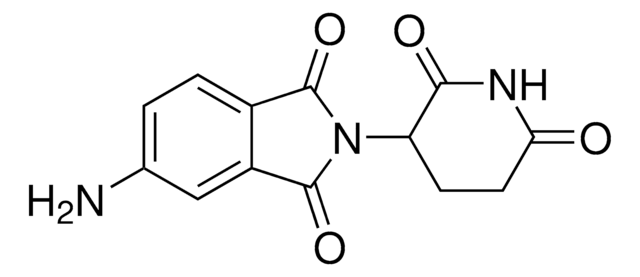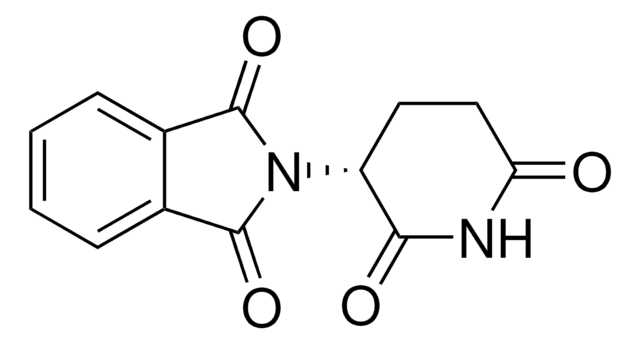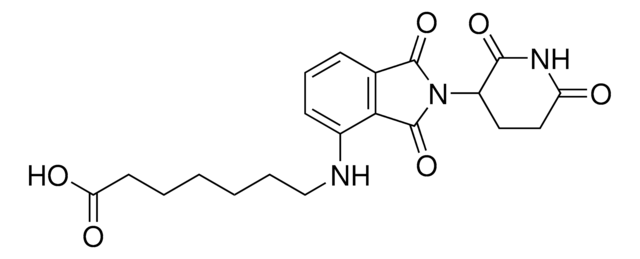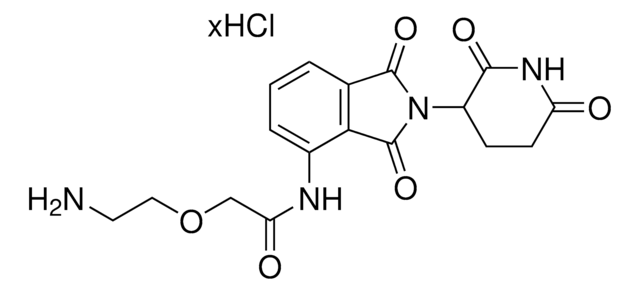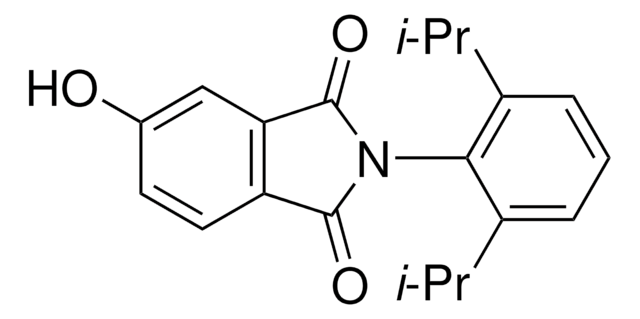P0018
Pomalidomide
≥98% (HPLC), powder, HbF inducer
Sinonimo/i:
1,3-dioxo-2-(2,6-dioxopiperidin-3-yl)-4-aminoisoindoline, 3-amino-N-(2,6-dioxo-3-piperidyl)phthalamide, 4-Amino-2-(2,6-dioxo-3-piperidinyl)-1H-isoindole-1,3(2H)-dione, Actimid, CC-4047, IMiD 3
About This Item
Prodotti consigliati
product name
Pomalidomide, ≥98% (HPLC)
ligand
pomalidomide
Livello qualitativo
Saggio
≥98% (HPLC)
Forma fisica
powder
Impiego in reazioni chimiche
reagent type: ligand
Colore
yellow
Solubilità
DMSO: ≥14 mg/mL
Temperatura di conservazione
2-8°C
Stringa SMILE
Nc1cccc2C(=O)N(C3CCC(=O)NC3=O)C(=O)c12
InChI
1S/C13H11N3O4/c14-7-3-1-2-6-10(7)13(20)16(12(6)19)8-4-5-9(17)15-11(8)18/h1-3,8H,4-5,14H2,(H,15,17,18)
UVSMNLNDYGZFPF-UHFFFAOYSA-N
Informazioni sul gene
human ... CRBN(51185) , CUL4A(8451) , DDB1(1642) , RBX1(9978)
Categorie correlate
Applicazioni
- to treat BV173 cells to study the role of proteolysis targeting chimera (PROTAC) compound, JQ1-CRBN, in inducing specific class-I major histocompatibility complex (MHC-I) peptides
- for apoptosis studies and intracellular calcium analysis
- as a fetal hemoglobin (HbF) agent to study the additive effect with UNC0638 on the levels of fetal hemoglobin expression in β-thalassemia/ variant hemoglobin E (HbE) erythroid progenitor cells
Azioni biochim/fisiol
Caratteristiche e vantaggi
Prodotti correlati
Avvertenze
Danger
Indicazioni di pericolo
Consigli di prudenza
Classi di pericolo
Repr. 1B
Codice della classe di stoccaggio
6.1C - Combustible acute toxic Cat.3 / toxic compounds or compounds which causing chronic effects
Classe di pericolosità dell'acqua (WGK)
WGK 3
Punto d’infiammabilità (°F)
Not applicable
Punto d’infiammabilità (°C)
Not applicable
Certificati d'analisi (COA)
Cerca il Certificati d'analisi (COA) digitando il numero di lotto/batch corrispondente. I numeri di lotto o di batch sono stampati sull'etichetta dei prodotti dopo la parola ‘Lotto’ o ‘Batch’.
Possiedi già questo prodotto?
I documenti relativi ai prodotti acquistati recentemente sono disponibili nell’Archivio dei documenti.
I clienti hanno visto anche
Il team dei nostri ricercatori vanta grande esperienza in tutte le aree della ricerca quali Life Science, scienza dei materiali, sintesi chimica, cromatografia, discipline analitiche, ecc..
Contatta l'Assistenza Tecnica.

